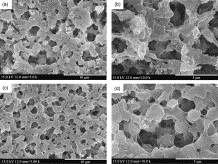Xiaofei Li, Mingzu Zhang,*(张明祖) Jinlin He, Dazhao Wu, Juwen Meng, Peihong Ni
College of Chemistry, Chemical Engineering and Materials Science, Jiangsu Key Laboratory of Advanced Functional Polymer Design and Application, Soochow University, Suzhou 215123, PR China
J. Membr. Sci. 2014, 455, 368–374.
In this paper, SiO2 nanoparticles were first modified with (heptadecafluoro-1, 1, 2, 2-tetradecyl)trimethoxysilane (TSL-8233) to improve its dispersibility and compatibility in the polymer matrix. The structure and property of SiO2 nanoparticles before and after modification were characterized by FT-IR, TGA and TEM analysis. Together with poly(vinylidene fluoride-co-hexafluoropropylene) (PVdF-HFP) and polypropylene (PP) nonwoven fabric, these SiO2 nanoparticles were then used to construct two kinds of composite separators (abbreviated as PHS for pristine SiO2 and PHS-8233 for modified TSL-8233@SiO2). The morphology, electrolyte uptake, ionic conductivity and electrochemical properties of the composite separators were analyzed by SEM analysis, AC impedance measurements, charge–discharge cycle and C-rate tests, respectively. These results indicated that PHS-8233 composite separator exhibited an improved pore distribution, electrolyte uptake (280 wt%) and ionic conductivity (1.90 mS cm−1). Even more importantly, LiFePO4/Li cells assembled with PHS-8233 composite separator displayed remarkable C-rate performance, which showed an enhancement in the chemical stability and discharge capacity. The capacity kept above 144 mA h g−1 after 100 charge–discharge cycles.

链接: //www.sciencedirect.com/science/article/pii/S0376738814000143